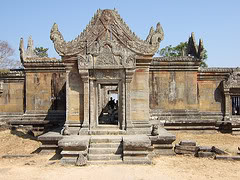Temple Gallery

Preah Vihear
.jpg)
Angkor Wat
.jpg)
Angkor Thom
.jpg)
Banteay Srei
.jpg)
Baphoun
.jpg)
Banteay Samre
.jpg)
East Bebon
.jpg)
Preah Kahn
.jpg)
Neak Pean
.jpg)
Ta Prohm
.jpg)
Ta Keo
.jpg)
Banteay Chhmar
).jpg)
Phnom BaKheng
Please click here to contact us click
Name : Banteay Srei |
.jpg)
|
Yajnyavaraha's temple was primarily dedicated to the Hindu god Shiva. Originally, it was carried the name Tribhuvanamahesvara — great lord of the threefold world — in reference to the Shaivite linga that served as its central religious image. However, the temple buildings appear to be divided along the central east-west axis between those buildings located south of the axis, which are devoted to Shiva, and those north of the axis, which are devoted to Vishnu.
The temple's modern name, Banteay Srei — citadel of the women, or citadel of beauty — is probably related to the intricacy of the bas relief carvings found on the walls and the tiny dimensions of the buildings themselves.Some have speculated that it relates to the many devatas carved into the walls of the buildings , the temple of Banteay Chhmar was constructed during the reign of Jayavarman VII in the late 12th or early 13th century. One of the temple's shrines once held an image of Srindrakumara rajaputra (the crown prince), probably a son of Jayavarman VII.
The long Old Khmer inscription found at the site (K.227), and now on display in the National Museum, Phnom Penh, relates how this prince or a king (samtac) was protected on two different occasions by four royal servants, all of whom lost their lives in his defense. The inscription lists the names of these officials and informs us that their respective images were once placed in the four corners of the shrine. The complex resembles Angkor Thom and other structures attributed to Jayavarman VII.
It is one of two sites outside Angkor with the enigmatic face-towers. Four stelae detailing Jayavarman VII's genealogy were placed (though they remain unfinished) at each of the four corners of the third enclosure wall, mirroring the stelae that occupied the four corner-shrines (Prasat Chrung) of the king's capital at Angkor Thom. Both Banteay Chhmar and the Bayon, Angkor Thom's central monument, are decorated with bas-reliefs depicting royal processions, battles with the Chams, and religious scenes.
The bas-reliefs of Banteay Chhmar once displayed eight exceptional images of Avalokiteśvara in the west gallery. Due to recent looting, only two of these images remain. As old as other famous Khmer temples from the Angkorian area, but lesser-known is Banteay Chhmar, or Narrow Fortress. At the center of this temple was one of the largest Buddhist monasteries of the Angkor period.
However, nowadays, little remains. Banteay Chhmar is slowly being smothered by crawling trees—the temple is being taken captive by the jungle. Banteay Chhmar is 63km north of Sisophon in Banteay Meanchey province. It was a city surrounded by a large moat and a 900m-long wall, and its bas-reliefs are believed to rival that of the Bayon, 150km away, in the Angkor Wat complex.
Although the jungle tries to subdue the grandeur of Banteay Chhmar, through small gaps in the trees, one large central tower can still be seen. It is adorned with four giant stone faces smiling out toward the compass points. Banteay Srei is a beautiful 10th century Khmer temple complex dedicated to the Hindu god Shiva. Located in the area of Angkor, it lies near the hill of Phnom Dei, 23 miles North of Angkor Wat.
Banteay Srei is built mainly of deep red sandstone, a material that lends itself to the elaborate wall carvings which are still well-preserved today. Banteay Srei means Citadel of Women and it is believed that the reliefs on this temple are so delicate that they could only have been carved by the hand of a woman. The relief carvings on the central buildings depict scenes from ancient Hindu myth. In fact, the buildings are miniature in scale compare to the standards of Angkorian construction. The remarkable craving skills and the red sandstone medium have made the temple very popular with tourists, and is widely praised as the "jewel of Khmer art.”
Created by IT student group at National University of Management 24/11/2009